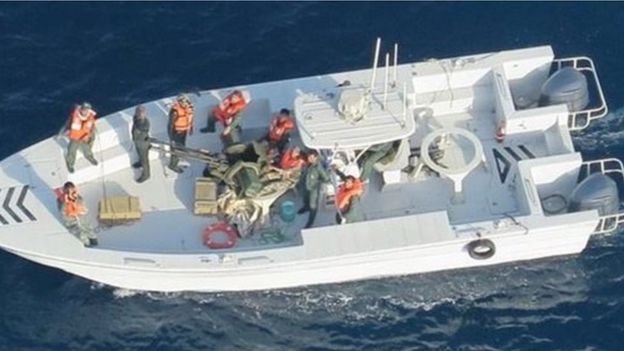Gulf crisis: US sends more troops amid tanker tension with Iran.

The US military will send an additional 1,000 troops to the Middle East as tensions build with Iran.
Acting Defence Secretary Patrick Shanahan said the deployment was in response to what he described as “hostile behaviour” by Iranian forces.
The US Navy also shared new images it says link Iran to attacks last week on two oil tankers in the Gulf of Oman.
Washington has accused Iran of blowing holes in the vessels with mines. Iran has denied the allegations.
Tensions were further fuelled on Monday when Iran said its stockpile of low-enriched uranium would next week exceed levels set under the 2015 nuclear agreement.
It recently stepped up production in response to the US tightening sanctions. The 2015 deal, from which the US has withdrawn, curbed Iran’s nuclear programme in exchange for the lifting of sanctions.
Meanwhile, on Monday night three rockets hit a military base housing US troops north of Baghdad, the Iraqi military said.The US said It was a direct fire and did not cause injuries.
No group has admitted responsibility for the attack, though it follows warnings by US officials of an increased threat to US interest in Iraq by Iran-backed militias.
What do we know about the extra troops?
The US troop deployment to the Middle East was announced by Mr Shanahan late on Monday.
In his statement, he said the “United States does not seek conflict with Iran” but the action was taken to “ensure the safety and welfare of our military personnel working throughout the region to protect our national interests”.
“The recent Iranian attacks validate the reliable, credible intelligence we have received on hostile behaviour by Iranian forces and their proxy groups that threaten United States personnel and interests across the region.”
He said the military would continue to monitor the situation and make adjustments to troop levels accordingly.
No details were given about where exactly the extra US forces would be posted.
Monday’s troop increase announcement comes on top of 1,500 extra announced by President Donald Trump last month.
Secretary of State Mike Pompeo said on Sunday that the US did not want war with Iran, but was nevertheless “considering a full range of options”.
He is due to meet the US military commander responsible for the Middle East at Central Command in Florida on Tuesday.
The 1,000 additional troops being despatched to the Middle East is presented as a prudent defensive measure by the Pentagon; the recent attacks on the two oil tankers being taken as a clear sign of Iran’s hostile intent.
They join some 1,500 additional troops sent last month. Taken together, these deployments inevitably raise tensions but they are clearly not in any sense an assault force.
If direct conflict does break out between Washington and Tehran, it will most likely be a sporadic air and maritime battle, not a land campaign.
But what worries Washington is attacks by the Iranian Revolutionary Guard Corps or Iran’s proxies against US troops or facilities in the wider region – hence this latest deployment.
The US defence secretary is again insisting that Washington does not want conflict with Tehran, but tensions remain high and any miscalculation could lead to a serious escalation.

What do the latest images show?
Shortly before the announcement, the Pentagon released new images including some purporting to show the remnants of an unexploded mine on a Japanese-owned oil tanker.
The photos appear to show it being removed by members of the Iranian Revolutionary Guard Corps. The Pentagon has already released grainy video said to show the same episode.
Also seen in the latest images is apparent damage – a hole – above the waterline on the hull of the Kokuka Courageous vessel.
Another image claims to show the Iranian Revolutionary Guard Corps vessel shortly after it was involved in removing the limpet mine.

A Norwegian-owned tanker, the Front Altair, also reported being hit by the blasts on Thursday.
The US has implicated Iran in the latest attacks and four others outside the Strait of Hormuz in May.
Iran has denied any involvement and called the latest US accusations “unfounded”.
Why are there new tensions?
In 2015, Iran agreed to a landmark deal with world powers to curb its nuclear development.
It agreed to limit the enrichment of uranium, which is used to make reactor fuel but also nuclear weapons, and other measures in return for relief from sanctions.
Mr Trump abandoned the nuclear accord last year and started to re-impose sanctions
The move has crippled Iran’s economy, which relies on oil, and Iran has responded by scaling back its nuclear commitments.
On Monday, a spokesman for its Atomic Energy Organisation said it was on course to exceed agreed limits on its low-enriched uranium stockpiles by 27 June.
But, Iran said there was “still time” for European countries to act by protecting Iran from reinstated US sanctions.
The US responded by accusing Iran of “nuclear extortion”.
(BBC)





